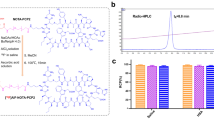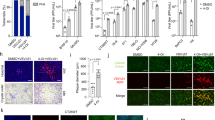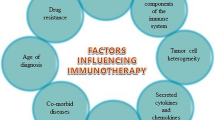Abstract
The treatment efficacy of Rituximab on lymphoma as an immunotherapeutic approach is confirmed, but this treatment has limited penetration through the brain micro vessels. Such limitation significantly attenuates the efficacy of systemic administration of this antibody on brain lymphomas. We aimed to confirm that Tadalafil, a long-acting phosphodiesterase type 5 inhibitor, could increase microvascular permeability and Rituximab treatment efficacy in brain lymphomas. We established a mouse brain lymphoma model by planting human-derived lymphoma cell line Raji into brain parenchyma of mice using stereotaxic techniques. After 16 days, 7.0 T magnetic resonance imaging was performed to confirm the presence of the mass. The mice were observed under near-infrared fluorescence after intravenous injection of fluorescence-labeled Rituximab. Evans Blue was used as probe to detect the microvascular permeability of brain lymphomas after Tadalafil administration. Starting from 4 days after implantation, the mice were administered different treatments. Survival analysis of brain lymphoma-loaded mice was performed. Evans Blue detection showed that Tadalafil administration could increase brain vascular permeability in the tumor-bearing group compared with control mice. Rituximab treatment prolonged the survival time of mice compared with the untreated control group (mean 25.75 vs. 20.8 days, p < 0.05). Tadalafil with Rituximab treatment resulted in the longest survival time (29 days, p < 0.05). Rituximab may be a promising therapeutic agent for the treatment of brain lymphoma. Tadalafil can enhance Rituximab treatment efficacy by improving the microvascular permeability in mice brain lymphoma.





Similar content being viewed by others
References
Gerstner ER, Batchelor TT (2010) Primary central nervous system lymphoma. Arch Neurol 67:291–297
Batchelor T, Loeffler JS (2006) Primary CNS lymphoma. J Clin Oncol 24:1281–1288
Mohile NA, Abrey LE (2007) Primary central nervous system lymphoma. Semin Radiat Oncol 17:223–229
Roth P, Korfel A, Martus P et al (2012) Pathogenesis and management of primary CNS lymphoma. Expert Rev Anticancer Ther 12:623–633
Marcus R, Hagenbeek A (2007) The therapeutic use of rituximab in non-Hodgkin’s lymphoma. Eur J Haematol 78:5–14
Rubenstein JL, Li J, Chen L et al (2013) Multicenter phase 1 trial of intraventricular immunochemotherapy in recurrent CNS lymphoma. Blood 121:745–751
Chamberlain MC (2013) Treatment of primary CNS lymphoma (PCNSL) following successful treatment of systemic non-Hodgkin’slymphoma (NHL): a case series. J Neurooncol 113:27–32
Hu J, Ljubimova JY, Black KL et al (2010) Phosphodiesterase type 5 inhibitors increase herceptin transport and treatment efficacy in mouse metastatic brain tumor model. PLoS One 5:e10108
Muldoon LL, Lewin SJ, Dósa E et al (2011) Imaging and therapy with rituximab anti-CD20 immunotherapy in an animal model of central nervous system lymphoma. Clin Cancer Res 17(8):2207–2215
Jiang H, Wang H, Tan Z et al (2011) Growth suppression of human hepatocellular carcinoma xenografts by a monoclonal antibody CH12 directed to epidermal growth factor receptor variant III. J Biol Chem 286:5913–5920
Li FQ, Zhang SX, An LX, Gu YQ (2011) In vivo molecular targeting effects of anti-Sp17-ICG-Der-02 on hepatocellular carcinoma evaluated by an opticalimaging system. J Exp Clin Cancer Res 30:25
Lampson LA (2011) Monoclonal antibodies in neuro-oncology: getting past the blood brain barrier. MAbs 3:1–8
Black KL, Yin D, Ong JM et al (2008) PDE5 inhibitors enhance tumor permeability and efficacy of chemotherapy in a rat brain tumor model. Brain Res 1230:290–302
Ravipati G, McClung JA, Aronow WS, Peterson SJ, Frishman WH (2007) Type 5 phosphodiesterase inhibitors in the treatment of erectile dysfunction and cardiovascular disease. Cardiol Rev 15:76–86
Baio G, Fabbi M, de Totero D, Ferrini S, Cilli M, Derchi LE, Neumaier CE (2006) Magnetic resonance imaging at 1.5 T with immunospecific contrast agent in vitro and in vivo in a xenotransplant model. MAGMA 19:313–320
Kadoch C, Li J, Wong VS et al (2014) Complement activation and intraventricular Rituximab distribution in recurrent central nervous system lymphoma. Clin Cancer Res 20:102941
Chacko AM, Li C, Pryma DA, Brem S, Coukos G, Muzykantov V (2013) Targeted delivery of antibody-based therapeutic and imaging agents to CNS tumors: crossing the blood-brain barrier divide. Expert Opin Drug Deliv 10:907–926
Black KL, Yin D, Konda BM et al (2008) Different effects of KCa and KATP agonists on brain tumor permeability between syngeneic and allogeneic rat models. Brain Res 1227:198–206
Acknowledgments
The author, Rong WANG, thanks Dr. Keith L. Black, Jinwei Hu and Julia Y. Ljubimova from Cedars-Sinai Medical Center, Los Angeles, California for introduction of this interesting field about increasing the microvascular permeability in brain tumors. This work was supported by Nanjing Medical Science and Technique Development Foundation and Key Project (YKK10065, YKK13077) and the Medical Science and Technology Development Foundation, Nanjing Department of Health.
Conflict of interest
The authors declare that they have no financial or other conflicts of interest in relation to this research and its publication.
Author information
Authors and Affiliations
Corresponding author
Additional information
Rong Wang, Wenli Chen and Qiang Zhang have contributed to the work equllly and should be regarded as co-first authors.
Rights and permissions
About this article
Cite this article
Wang, R., Chen, W., Zhang, Q. et al. Phosphodiesterase type 5 inhibitor Tadalafil increases Rituximab treatment efficacy in a mouse brain lymphoma model. J Neurooncol 122, 35–42 (2015). https://doi.org/10.1007/s11060-014-1690-0
Received:
Accepted:
Published:
Issue Date:
DOI: https://doi.org/10.1007/s11060-014-1690-0




